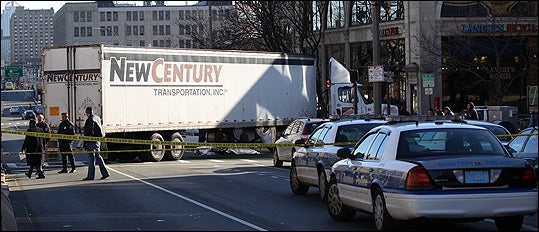
Comments below are by Kirby Beck, who worked on the Weigl crash as an expert consultant. Beck is a retired police officer, avid recreational cyclist, co-founder and trainer #02 of the International Police Mountain Bike Association.
I phoned Beck on January 7, 2025 to assure that I have permission to publish his comments. During the phone call, he made a few additional observations:
- The Boston Police did an excellent job investigating the crash. (Their investigation is the major source for Beck’s observations.)
- “My experience continues to be when there is a bike lane cyclists tend to concentrate on keeping it between the lines and feeling they are impervious (and oblivious) to the surrounding traffic.”
- Beck would like to be defending cyclists and also would like to have less business, but trucking companies are calling on him.
- Beck reiterated that Chris Weigl struck the cab of the truck. “He hit the step, it turned his front wheel to the right and he fell to the left … unfortunately, the heaviest wheels of the truck were there waiting for him.”
And so, side guards would on the truck would not have prevented the crash from becoming fatal. A barrier between the bike lane and travel lanes woule have been of questionable help, because the truck would still have been crossign the cyclist’s path from the left — as in the Anita Kurmann fatality in 2015 and the Kim Staley fatality in Cambridge, summer of 2024.
Beck’s comments from his e-mail:
As I remember there was a bike lane – not shown in the diagram. It was a very tight turn onto a narrow street and the truck was in the middle lane. Motorists around him knew he was going to turn and were yielding to him to allow him to do so. The cyclist was riding in the bike lane, down a grade towards the intersection. He was riding very fast. (20 mph+ I seem to remember.) The bike was still in a very high gear as it was photographed at the scene. Traffic on the roadway was heavy and backed up as it was morning rush hour. When the truck driver began his turn the cyclist was probably a block or more away. The cyclist would likely have been screened by stopped vehicles in the right lane and it’s questionable if he was even visible to the trucker. The cyclist should have been able to see the truck, but he may not have been able to see its turn signals (which were clearly on.)
As the cyclist approached the intersection he finally realized what was happening as the truck started across the bike lane. The cyclist braked hard, but it was too late. He struck the side of the cab and was thrown under its rear set of tires. Very sad. My take away for cyclists – don’t just watch the paint and think that because you’re in a bike lane you can ride like it’s “ally ally all’s in free.” You have to keep speed under control to allow you to observe what vehicles around you are doing. Bike lanes are still part of traffic and have to be prepared to react to it. I guess this supports my belief that riding as part of traffic is safer than the supposedly “safer” bike lanes, even if it takes a little longer.
I worked another truck crash with a cyclist in a bike lane. The cyclist left 31 feet of rear wheel skid right up the rear tandem (set of wheels/tires) on a semitrailer. How fast do you think he was going? A reconstructionist estimated he would have been a block and a half away when the truck started the turn. Tell me again who had the Right of Way!
I imagine there are some who say I’m blaming the victim – but those are the facts and the facts don’t assess blame, they only tell what happened.
I have also created a 30-foot skid mark, in a braking test. A long skid mark not only testifies to speed, it testifies to overuse of the rear brake. Compared with rear-wheel-only braking, stopping distance is halved if the front brake is used to its safe limit.
For maximum deceleration from high speed, the rear brake should be used only lightly, to provide a signal that most weight is on the front wheel, while avoiding the risk of pitching forward. The front wheel will not skid, and the rear wheel will leave only a light, intermittent skid mark. But, unless cyclists have received instruction and practiced emergency braking, they will fear the front brake. That is what novices and children are told to do, and most cyclists never get past that stage.
Courses of instruction — in the USA, CyclingSavvy, and the League of American Bicyclists Smart Cycling course — teach this technique, but unfortunately, most cyclists go without instruction. Courses also warn cyclists to look over their left shoulder fro turning traffic if entering an intersection to the right of through traffic.

Leave a Reply
You must be logged in to post a comment.